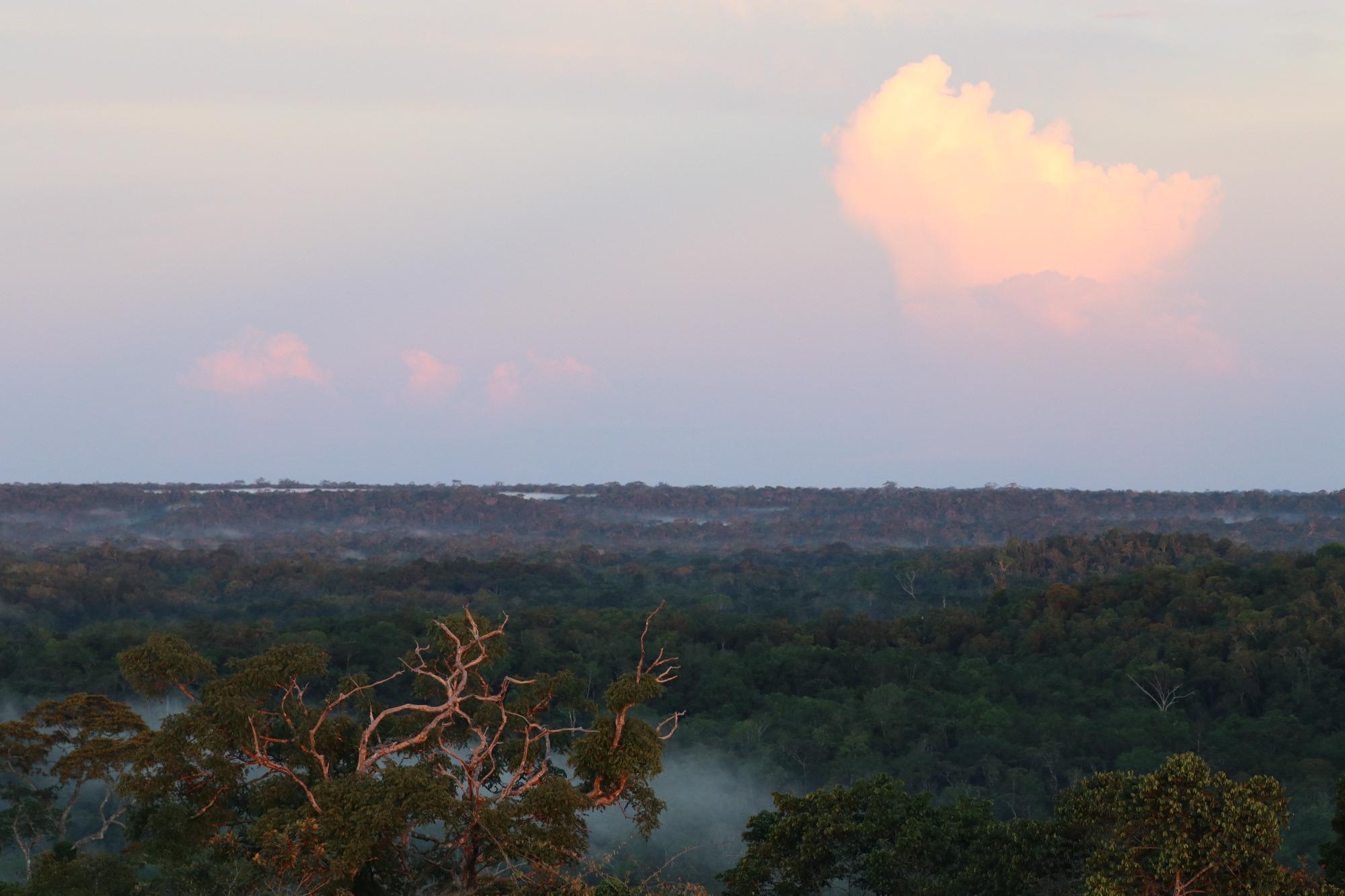According to a new study by Louisiana State University (LSU) researchers, the most untouched areas of the Amazon rainforest devoid of direct human contact are being influenced by human-contributed climate change.
 Above the Amazon rainforest canopy where birds have become smaller and their wings have become longer over several generations, indicating a response to the shifting environmental conditions that may include new physiological or nutritional challenges. (Image Credit: Vitek Jirinec, Louisiana State University).
Above the Amazon rainforest canopy where birds have become smaller and their wings have become longer over several generations, indicating a response to the shifting environmental conditions that may include new physiological or nutritional challenges. (Image Credit: Vitek Jirinec, Louisiana State University).
The latest analyses of data gathered over 40 years reveal that not only has the number of sensitive local birds all over the Amazon rainforest dropped, but the body size and wing length have become different for most of the examined species. These physical differences in the birds track progressively dry and hot conditions in the dry season (June to November).
Even in the middle of this pristine Amazon rainforest, we are seeing the global effects of climate change caused by people, including us.
Vitek Jirinec, Study Lead Author and Associate Ecologist, Integral Ecology Research Center
Vitek Jirinec is LSU alumnus (Ph.D. ’21). This study was published in the journal Science Advances.
The size of birds in the Amazon rainforest has become smaller, and their wings have become longer over a number of generations, signifying a reaction to the ever-changing environmental conditions that may include new nutritional or physiological issues.
This is the first research to ascertain these changes in the body size and shape of non-migratory birds, which removes other factors that may have impacted these physiological alterations. Jirinec and colleagues examined data gathered on over 15,000 individual birds that were captured, weighed, measured, marked with a leg band and released - more than 40 years of fieldwork in the largest rainforest in the world.
The data reveal that approximately all of the birds’ bodies have decreased in mass, or become lighter, from the 1980s. The majority of the bird species lost on average around 2% of their body weight every 10 years. For an average bird species that weighed approximately 30 g in the 1980s, the population currently averages approximately 27.6 g. How major is this?
These birds don’t vary that much in size. They are fairly fine-tuned, so when everyone in the population is a couple of grams smaller, it’s significant.
Philip Stouffer, Study Co-Author, the Lee F. Mason Professor, School of Renewable Natural Resources, LSU
The data set encompasses a huge range of the rainforest, so the alterations in the bodies and wings of birds across communities are not fixed to one particular site, which means that the occurrence is universal.
This is undoubtedly happening all over and probably not just with birds...If you look out your window, and consider what you’re seeing out there, the conditions are not what they were 40 years ago and it’s very likely plants and animals are responding to those changes as well. We have this idea that the things we see are fixed in time; but if these birds aren’t fixed in time, that may not be true.
Philip Stouffer, Study Co-Author, the Lee F. Mason Professor, School of Renewable Natural Resources, LSU
The researchers examined 77 species of rainforest birds that reside in the cool, dark forest floor to the warmer, sunlit midstory. They learned that the birds that live in the highest section of the midstory that are the most exposed to heat and drier environments, had the most vivid change in wing size and body weight. These birds are also inclined to fly more than the birds that reside on the forest floor.
The impression is that these birds have adjusted to a hotter, drier climate by minimizing their wing loading, thus becoming more energy efficient when they flew. Quite like a fighter jet, with a weighty body and short wings that requires plenty of energy to fly fast compared to a glider plane with a thin body and long wings that can fly with minimal energy.
If a bird possesses a higher wing loading, it has to flap its wings faster to remain aloft, which necessitates more energy and generates more metabolic heat. Minimizing body weight and increasing wing length results in more competent resource use while also staying cooler in a warming climate.
LSU alumnus Ryan Burner (Ph.D. ’19) performed much of the analysis that exposed the disparity among the flocks of birds over the years. Burner, who is currently a research wildlife biologist at the U.S. Geological Survey Upper Midwest Environmental Sciences Center, is the study’s second author.
The issue of the future capacity of Amazonian birds to deal with progressively hotter and drier environments, particularly in the dry season, remains unresolved. The same issue can be related to many places and species that reside at the edges of even more ecological extremes.
There may be other researchers in other places who have relevant data from the 1970s and 1980s that could be compared to modern data, because the bird banding protocol we used is pretty standard.
Philip Stouffer, Study Co-Author, the Lee F. Mason Professor, School of Renewable Natural Resources, LSU
“So if you measure mass and wing, maybe there will be more datasets that will emerge and we’ll be able to get more of an idea of the variation across space and how it might be changing in different systems,” Stouffer added.
Journal Reference:
Jirinec, V., et al. (2021) Morphological consequences of climate change for resident birds in intact Amazonian rainforest. Science Advances. doi.org/10.1126/sciadv.abk1743.